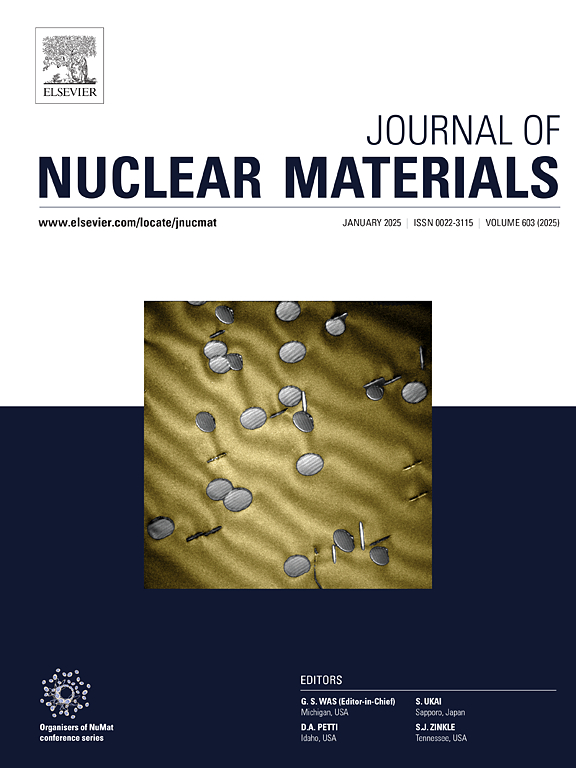质子辐照诱导CrFeMnNi高熵合金显微组织的变化
IF 3.2
2区 工程技术
Q3 MATERIALS SCIENCE, MULTIDISCIPLINARY
引用次数: 0
摘要
与纯金属和一些传统合金相比,高熵合金表现出优越的耐辐射能力。然而,高熵固溶体微观结构在高温级联辐照环境中的稳定性尚未得到很好的理解。在这项研究中,我们研究了一种CrFeMnNi高熵合金(HEA)在2 MeV质子辐照下的微观组织演变:2.8 dpa, 400°C, 2.8 dpa, 600°C和16.8 dpa, 400°C。采用扫描透射电镜(S)TEM)、能量色散x射线能谱(EDS)和电子能量损失能谱(EELS)对辐照引起的微观结构变化进行了表征。损伤高原地区辐照诱发的弗兰克环具有统计学特征。在400℃下辐照2.8 dpa的样品中,Frank环的密度最高,而在600℃下辐照的样品中Frank环的平均尺寸最大。随着辐照温度的升高,样品的分解程度逐渐增大,并出现了Spinodal分解和l10型NiMn有序化现象。此外,在Frank环路周围观察到Ni和Fe的偏析和Mn的耗竭。在600°C样品中,仅在Cr析出物中观察到空洞,这是由于Cr析出相关的过量空洞。本文章由计算机程序翻译,如有差异,请以英文原文为准。
Proton irradiation-induced microstructure changes in a CrFeMnNi high entropy alloy
High entropy alloys have demonstrated superior radiation tolerance compared to pure metals and some conventional alloys. However, the stability of high entropy solid solution microstructure within a cascade-involved irradiation environment at elevated temperatures has not been well understood. In this study, we examined the microstructural evolution of a CrFeMnNi high entropy alloy (HEA) subjected to irradiation with 2 MeV protons under three different conditions: 2.8 dpa at 400 °C, 2.8 dpa at 600 °C, and 16.8 dpa at 400 °C. The irradiation-induced microstructural changes were characterized using (scanning) transmission electron microscopy ((S)TEM) combined with energy dispersive x-ray spectrometry (EDS) and electron energy loss spectroscopy (EELS). Irradiation-induced Frank loops in the damage plateau areas were statistically characterized. The samples irradiated to 2.8 dpa at 400 °C exhibited the highest density of Frank loops, whereas the largest average size of Frank loops was observed in the sample irradiated at 600 °C. Spinodal decomposition and L10-type NiMn ordering were observed in the irradiated samples, with the extent of decomposition increasing with irradiation temperature. Additionally, segregation of Ni and Fe and depletion of Mn were observed around Frank loops. Voids were observed only within the Cr precipitates in the 600 °C sample, which is attributed to the excess vacancies associated with Cr precipitation.
求助全文
通过发布文献求助,成功后即可免费获取论文全文。
去求助
来源期刊

Journal of Nuclear Materials
工程技术-材料科学:综合
CiteScore
5.70
自引率
25.80%
发文量
601
审稿时长
63 days
期刊介绍:
The Journal of Nuclear Materials publishes high quality papers in materials research for nuclear applications, primarily fission reactors, fusion reactors, and similar environments including radiation areas of charged particle accelerators. Both original research and critical review papers covering experimental, theoretical, and computational aspects of either fundamental or applied nature are welcome.
The breadth of the field is such that a wide range of processes and properties in the field of materials science and engineering is of interest to the readership, spanning atom-scale processes, microstructures, thermodynamics, mechanical properties, physical properties, and corrosion, for example.
Topics covered by JNM
Fission reactor materials, including fuels, cladding, core structures, pressure vessels, coolant interactions with materials, moderator and control components, fission product behavior.
Materials aspects of the entire fuel cycle.
Materials aspects of the actinides and their compounds.
Performance of nuclear waste materials; materials aspects of the immobilization of wastes.
Fusion reactor materials, including first walls, blankets, insulators and magnets.
Neutron and charged particle radiation effects in materials, including defects, transmutations, microstructures, phase changes and macroscopic properties.
Interaction of plasmas, ion beams, electron beams and electromagnetic radiation with materials relevant to nuclear systems.
 求助内容:
求助内容: 应助结果提醒方式:
应助结果提醒方式:


